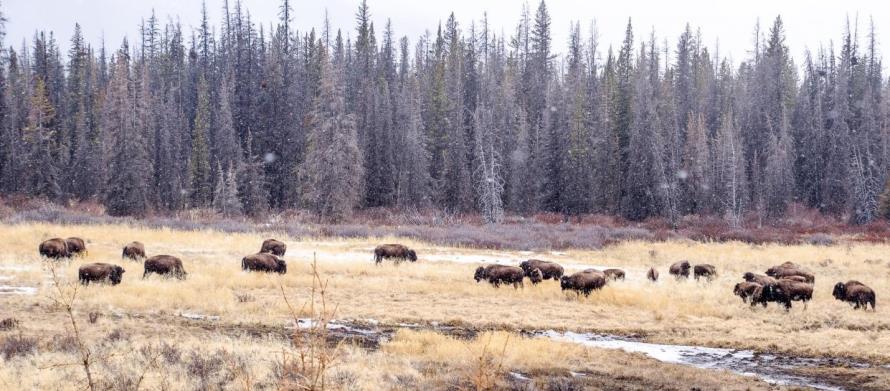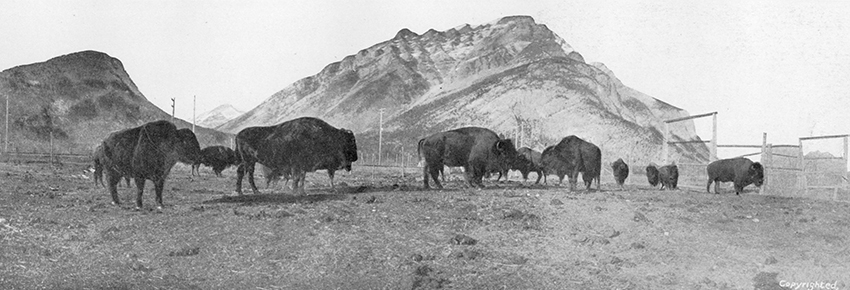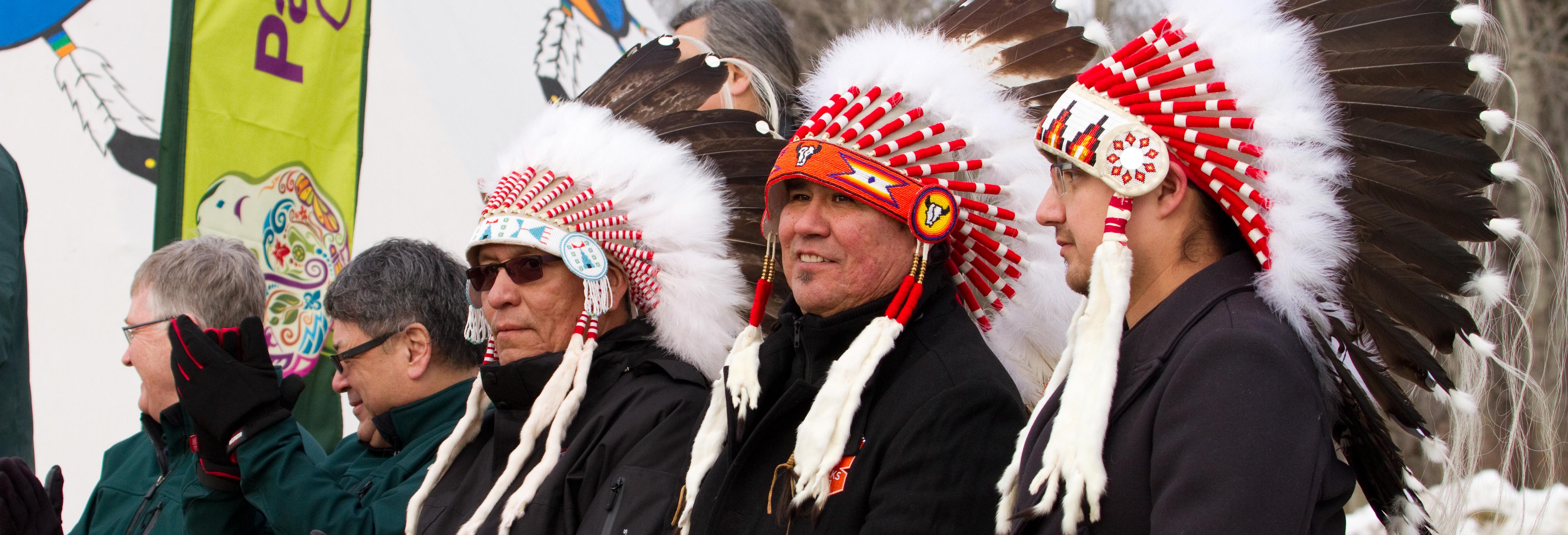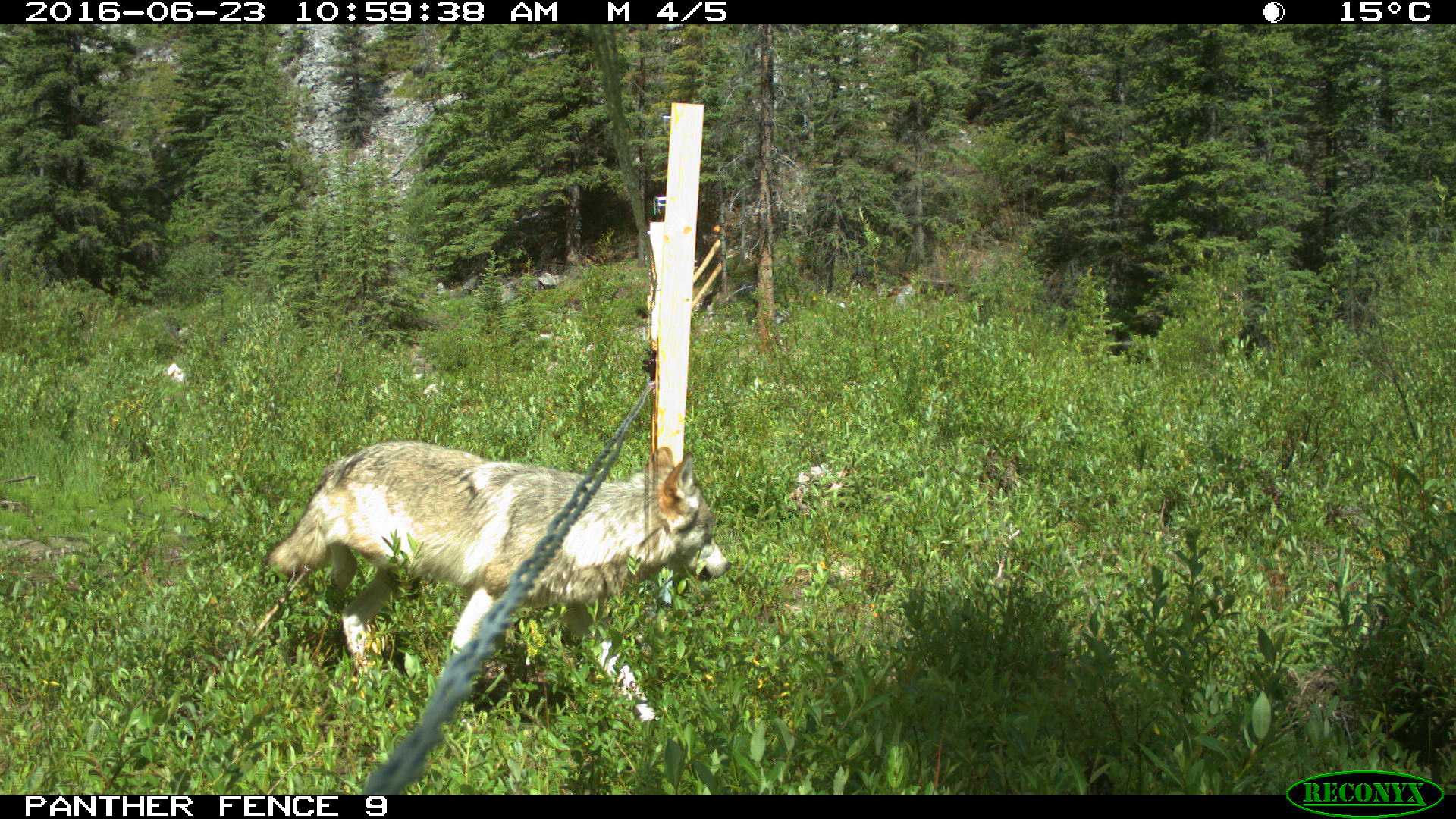
Frequently asked questions
Banff National Park
New Informed by Indigenous, stakeholder and public review and input, Parks Canada is pleased to present the final Report on the Plains Bison Reintroduction Pilot 2017-2022. The Report follows the direction of the 2015 Plains Bison Reintroduction Plan, summarizes key learnings, and provides a basis to understand the feasibility of managing bison on the landscape.
Over a 30-day engagement period, from November 9, 2022 – December 14, 2022, the Agency sought perspectives from Canadians on the future of bison management in Banff National Park. Indigenous groups, stakeholders, and the public were encouraged to review the Draft Report and share their feedback.
The engagement process has now concluded. The final report is now available to the public, along with a ‘What We Heard’ summary of the recent engagement. Parks Canada is pleased to announce that, moving forward, Banff will work towards keeping bison on the landscape within Banff National Park while the Agency explores future options for bison management through the development of a bison management plan. Indigenous peoples and stakeholders will continue to be informed and involved throughout this process.
Final Report on the Plains Bison Reintroduction Pilot 2017-2022
Why bring bison back to Banff National Park?
Why bring bison back to Banff National Park?
Wild bison disappeared from what is now called Banff National Park before the park was created in 1885.
Restoring bison in Banff is important for the following reasons:
Ecological and Conservation BenefitsBison are key grazers that once shaped the valleys in what is now Banff National Park. As “ecosystem engineers,” they change the landscape in ways that help many plants and animals.
Cultural Reconnection
Bison were a vital part of the lives of indigenous people in this area, and they still play an important role in many indigenous cultures. Restoring bison to the landscape will renew cultural and historical connections.
Inspiring Discovery
The return of bison will provide opportunities for visitors and Canadians to learn about the ecological and cultural importance of this iconic animal.
What will the reintroduction look like?
The Conclusion of the Pilot (2022)
- Parks Canada has reached the end of the five-year Plains Bison Reintroduction Pilot. To mark this conclusion, Parks Canada prepared the Report on the Bison Reintroduction Pilot 2017 – 2022 and sought feedback from Indigenous groups, stakeholders, and the public over a 30-day engagement period. From November 9, 2022 – December 14, 2022 Canadians were encouraged to review the Report and share feedback.
- Comment and questions received during engagement helped to inform and finalize the Report on the Plains Bison Reintroduction Pilot 2017-2022. The final report is now available to the public, along with a ‘What We Heard’ summary of engagement.
Next Steps (2023 and Ongoing)
- The reintroduction pilot has helped Banff National Park understand how we can keep bison on the landscape in Banff National Park. Based on the feedback received throughout the five-year pilot and the recent public engagement period, support for bison reintroduction to Banff National Park continues to be high.
- Parks Canada is pleased to announce that, moving forward, we will work towards keeping bison on the landscape within Banff National Park while the Agency explores future options for bison management through the development of a bison management plan.
What is the Report on the Plains Bison Reintroduction Pilot 2017-2022?
The Report on the Plains Bison Reintroduction Pilot summarizes what Parks Canada learned over the 5-year pilot period bison were reintroduced and managed in Banff National Park. The Report summarizes the results of the pilot and includes results of the reintroduction and subsequent monitoring.
Comment and questions received during engagement helped to inform and finalize the Report on the Plains Bison Reintroduction Pilot 2017-2022. The final report is now available to the public, along with a ‘What We Heard’ summary of engagement.
What were the goals of the pilot and were they achieved?
The goals and objectives of the Reintroduction Pilot included supporting ecosystem integrity, enriching visitor experience, facilitating cultural connections, and providing learning and stewardship opportunities, both in the park and from afar. Overall, the goals and objectives of the pilot were achieved.
- The bison remained healthy and demonstrated a healthy growth rate with minimal mortalities, they appear to have adapted quickly to the mountain habitat, and they remained, for the most part, within the Park.
- Negative impacts to other species were not observed, and there were no threats to human safety or property damage reported.
- Establishing and strengthening relationships occurred through the involvement of a number of Indigenous Nations and stakeholders throughout the pilot.
- A variety of educational programs provided the opportunity to enrich visitor experience and understanding.
How did Parks Canada evaluate the success of the pilot?
Based on the 2015 Reintroduction Plan for Plains Bison, Parks Canada evaluated eight (8) key indicators, the results of which are included in the Report:
- Visitor safety and experience impacts;
- Relationships with Indigenous groups and stakeholders;
- Response to citizen engagement and stewardship programs;
- Bison home ranges, monitoring and responses;
- Mitigating effects of the bison project on other species;
- Bison population growth and population targets;
- Public awareness, education and appreciation;
- Factors influencing bison movement and habitat selection.
Have people followed the journey of the bison reintroduction project in Banff so far?
Yes! Almost 120 million people watched, read, and listened to updates about the project over the last 5 years. The Bison Reintroduction Pilot offered Canadians many learning opportunities to enrich visitor experience and understanding of ecological restoration in national parks.
Are the bison now self-sustaining?
Yes, and no. The 16 animals which were translocated from Elk Island National Park in 2017 adapted quickly to Banff’s mountain environment and now number about 80 animals, showing robust health and growth. However, the bison still require periodic management to keep them in the 1200 km2 reintroduction zone, including short sections of wildlife-friendly bison drift fencing, and infrequent herding and recapture of wayward animals by the Parks Canada team.
The pilot has now concluded. What happens now? How do I get involved?
Parks Canada is pleased to announce that, moving forward, we will work towards keeping bison on the landscape within Banff National Park while the Agency explores future options for bison management through the development of a bison management plan. Indigenous peoples and stakeholders will continue to be informed and involved throughout this process.
Where are the bison now?
Where are the bison now?

Imagine a network of river valleys that wind through lush meadows. Tall grassy slopes glow against a backdrop of snow-covered peaks. If you listen at dusk, you may hear the haunting beauty of an elk bugle or a pack of wolves howling in the distance.
That is a glimpse of the remote eastern slopes of Banff National Park. Now home to big horned sheep, elk, bears, wolves, and…bison!
In summer 2018, the herd was released in a 1200 km2 reintroduction zone, spanning a large portion of the eastern slopes of Banff National Park including parts of the Panther, Dormer, Cascade and Red Deer River Valleys.
Where is the reintroduction zone?

Where is the reintroduction zone?
For the scope of this pilot project, the herd will roam a reintroduction zone spanning 1200 km2 in the eastern slopes of Banff National Park. This remote wilderness area provides the grassy valleys that bison need to thrive.
The Panther and Dormer River Valleys form the core of the area. The herd will also be able to explore parts of the Red Deer and Cascade River Valleys within the first few years of the free-roaming phase.
Short stretches of wildlife-friendly fencing on the edges of the reintroduction will encourage bison to remain within the reintroduction zone while allowing other wildlife to pass safely.
How can I experience bison in the front country?
How can I experience bison in the front country?
Although the bison roam a remote part of Banff National Park, we are working hard to bring this incredible story of conservation and connection to Canadians and visitors from around the world. Here are some ways you can follow the herd:
Here are some ways you can connect with Banff’s bison story:
- Follow our Bison Blog
- Follow us on social media: @BanffNP on Twitter and Facebook and #BanffBison
- Watch our YouTube webseries
- Learn more: attend a fun interpretive program in the Banff townsite and day-use areas (visit parkscanada.gc.ca/banff-interpretation).
Are there any impacts on backcountry users?
Are there any impacts on backcountry users?
Backcountry users can access the reintroduction zone on foot or by horseback. See answers to questions below for guidelines for safe travel in bison country and for permitting information.
Can I see the bison?
Can I see the bison?
The herd roams Banff’s remote eastern slopes. For experienced backcountry users travelling in this area, it may be possible to encounter free-roaming bison. Like all wildlife in national parks, chances to see wildlife are special, unpredictable and never guaranteed.
It is also possible, but unlikely, that bison may be encountered at any time outside of the intended reintroduction zone. For information on safe-viewing practices for bison and other wildlife, please visit our website.
What do I need to know before travelling in bison country?
What do I need to know before travelling in bison country?
- Experienced backcountry users interested in travelling to the Panther Valley area need to be prepared for remote, non-motorized backcountry travel. The soft-release pasture is located in one of the most remote backcountry areas within Banff National Park – approximately 40 km from the nearest road.
- Visitors traveling in the backcountry must purchase a wilderness pass and backcountry camping fees (and grazing fees for equestrian users).
- Book your backcountry travel at visitor centres located in Banff, Jasper, Kootenay and/or Yoho national parks.
Check for regular safety updates and information regarding backcountry travel.
How did the bison get to Banff?
How did the bison get to Banff?
Watch the behind-the-scenes journey of bringing bison from Elk Island National Park to Banff.
How will bison shape the landscape?
How will bison shape the landscape?
Bison are called ecosystem engineers or keystone species. That means that they alter the landscape in ways that benefit many other plants and animals. For example:
- Bison fur provides insulation for bird nests.
- Their grazing patterns create vibrant habitat for other grazers such as elk.
- As North America’s largest land mammal, bison provide a rich source of nutrients for scavengers, bears and wolves.
We will be monitoring how the return of bison influences the landscape as they start to fulfil their role as a keystone species once again.
How are the bison doing?
How are the bison doing?
The recently reintroduced bison are doing well. They are in the Panther and Red Deer Valleys of Banff National Park, well within the target reintroduction zone. They are spending most of their time on grassy slopes and in open meadows. Their daily movements are shorter in winter than in spring, summer and fall.

How many bison are in the Banff herd?
How many bison are in the Banff herd?
As of January 2020, there are 35 animals in the herd: three adult bulls, the 10 original cows, 10 two-year-olds (born in the soft release pasture in 2017), 10 yearlings (born in 2018) and two calves born in 2019. A third calf (born in June 2019) has since died of natural but unknown causes.
What caused the near-extinction of bison?
What caused the near-extinction of plains bison across North America?

For thousands of years, vast herds of plains bison traveled the plains of North America. Some also roamed the area that is now Banff National Park.
Once thundering in numbers as large as 30 million, bison nearly became extinct within a single human lifetime. Although many factors led to their near-disappearance, over-hunting was the main cause that left fewer than 1,000 bison.
Luckily, bison were given a second chance – thanks in large part to the conservation leadership of Parks Canada.
What role does Parks Canada play in bison conservation?
What role does Parks Canada play in bison conservation?
Banff National Park’s reintroduction is a new chapter in the larger story of Parks Canada’s bison conservation legacy.

Banff National Park (then Rocky Mountains Park) protected the first display herd of bison in 1897, and since then, Parks Canada has been an international leader in bison conservation.
In 1907, the Government of Canada purchased one of the last and largest herds of surviving bison from a rancher in Montana. The descendants of those bison created Parks Canada’s seed herd at Elk Island National Park that supports bison restoration projects worldwide.
Parks Canada also manages wild, free-roaming bison in Prince Albert National Park and Wood Buffalo National Park and protects several display herds across the country.
What’s the difference between bison and buffalo?
Bison or buffalo?
It depends! In general, when people in North America use the term “bison” or “buffalo”, they usually mean the American bison. The term “buffalo” is a more informal name, whereas their scientific name is bison.
There are also two true species of buffalo – the Asian water buffalo and the African buffalo. The American bison is distantly related to those species, but most closely related to the European bison (or wisent).
Parks Canada tends to use “bison”, but both terms are correct. Many indigenous nations commonly refer to them “buffalo”.
How are you involving Indigenous people in the reintroduction?
How are you involving Indigenous peoples in the reintroduction?
There is a strong connection between Indigenous culture and bison.
To honour that special relationship, Parks Canada is committed to welcoming indigenous peoples to reconnect with bison as part of the reintroduction. Parks Canada involved several Indigenous communities in the consultation phases of the project, and the reintroduction will continue to be built through collaboration and cooperation.

Making sure that bison received proper blessings before they returned to the Banff landscape was a key part of the project. Parks Canada hosted a blessing ceremony on the shore of Lake Minnewanka with Buffalo Treaty signatories and celebrated at a second ceremony at Elk Island to mark the departure of the herd to Banff.
This is the beginning of what we hope will be a long and fruitful relationship with these communities as bison return to the ecological – and cultural – landscape of Canada’s first national park.
How would you keep bison from leaving the reintroduction zone?
How would you keep bison from leaving the reintroduction zone?
Parks Canada is using a comprehensive approach to encourage bison to remain within the reintroduction zone. This includes:
- Selecting a reintroduction zone that is mostly naturally contained with steep, rocky ridges;
- Taking a “soft-release” approach by holding the herd in an enclosed pasture for 16 months to allow the herd to calve twice and anchor to their new home;
- Using short stretches (approx. 7 km) of wildlife-friendly wire fencing in key pinchpoints to discourage bison from leaving the reintroduction zone;
- Burning meadows to create additional attractive bison habitat;
- Monitoring the herd by maintaining satellite linked GPS collars on at least 10% of the animals;
- Responding quickly to reports of bison excursions from the reintroduction zone, and using herding, gentle hazing and baiting techniques to bring them back.
What kind of fencing will you use?

What kind of fencing will you use?
Bison share their new home with other native species, including bighorn sheep, elk and bears.
To discourage bison from leaving the reintroduction zone while allowing other wildlife species to cross freely, we are using wildlife-friendly fencing at key pinch-points on the edges of the reintroduction zone.
To determine an ideal design, we completed a year of fence design testing at key locations in the reintroduction zone. Based on the findings, we chose an adjustable wire fence that exceeds all standards for wildlife-friendly fencing elsewhere in North America
How can you be sure that introduced bison are healthy?
How can you be sure that reintroduced bison are healthy?
The chance of bison introducing or being exposed to diseases such as bovine tuberculosis, brucellosis or anthrax in Banff National Park is estimated to be negligible-to-low.
Due to the potential negative impacts linked to these diseases, we developed a Bison Health Monitoring and Disease Response Plan with the Province of Alberta.
Key components of the plan include:
- Only healthy bison were released into Banff National Park. The animals were chosen from Elk Island National Park, a brucellosis and tuberculosis-free area for more than 40 years.
- Careful health monitoring of the herd and immediate follow-up of any symptoms by a wildlife health specialist.
- Minimizing interaction with neighbouring livestock by encouraging bison to remain within the reintroduction zone.
- In the unlikely event that disease is detected, acting quickly to prevent further risks to bison or any other species. This response may include additional disease testing, monitoring, quarantine, and if necessary, culling the herd.
What should people do if they encounter a free-roaming bison?
What should people do if they encounter a free-roaming bison?
It is important to note that bison may be encountered within or beyond the reintroduction zone at any time.
If you encounter free-roaming bison:
- Maintain a safe distance of 100 metres from bison when traveling by foot or by horseback.
- Use binoculars or a telephoto lens to get a closer look.
- If you encounter bison, do not approach. Choose an alternate route. Watch their movements and give them space (100 metres).
- If a bison approaches you, remain calm and do not run. Back away slowly and try to maintain a physical barrier, such as a tree, between you and the animal.
- Be especially wary of female bison with young calves (spring) and male bison during rutting season (July/August).
- Dogs must be on leash and under control at all times. • Respect all warnings, area closures, and travel restrictions.
If you encounter an aggressive bison, please notify Banff Dispatch at 403-762-1470 when safe to do so.
Related links
- Date modified :